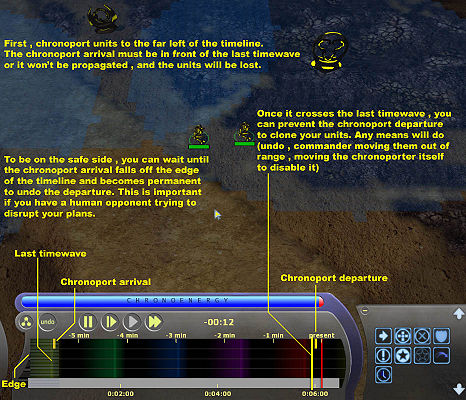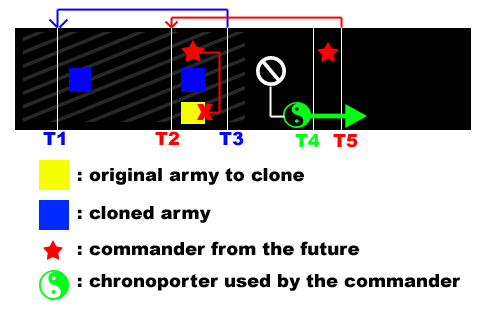Chronocloning
Using chronoporting or wave propagation artifacts to make multiple instances of the same units. Chronocloning can mean to either use a force to travel back in time and assist its previous versions, or to use time window and events falling off the timeline in order to create permanent clones of units known as permacloning.
Chronoporting units to the past will produce stable chronoclones, which can add up; past instances will be around until they take the chronoporter, and future instances will be removed by timewaves if they cannot.
Chronoporting units to the future will only produce unstable chronoclones as timewaves will update the timeline, removing the versions that didn't chronoport.
Contents |
Surf cloning
Continually chronoporting units in front of a given timewave, doubling their numbers with each iteration. Since the timewave didn't register the chronoport departure event, arriving units will meet up with their past selves - which are virtual units and will be erased by the next timewave. As long as they don't interact with it, they can be combined to chronoport again. Be careful with chronofrags when attempting to surfclone - you will have to move your units around before chronoporting.
Surfclones can be made permanent with basic permacloning.
55 seconds run of the Chronoclone Challenge using surfcloning, by Iago
Permanent Chronocloning
Because Resequence handles a limited timeframe, events become permanent when they leave the time window as the game progresses. With chronoporting, you are allowed to change history to not be causally consistent with permanent events; the most practical application is to duplicate units, by cancelling their chronoporting after their arrival becomes permanent.
This is only possible in specialized maps such as the Chronoclone Challenge or Clone Tactics, however. It will not work in normal conditions due to a longer unplayable past and limited chronoport distance.
Regardless of the method used, chronoporting costs will be refunded once you successfully permaclone units. Still, you need resources to initiate it.
Paradox cloning
Since paradoxes constantly change the timeline with each update, they have useful applications in permacloning. The easiest method is to make a Selfdrag Grandfather paradox, which produces double the units in one of the phases and none in the other. When the paradox settles, you will obtain permanent clones if you timed it right.
This method allows permacloning regardless of game settings (as long as the time window is not static) but is subject to interference from observation. Therefore, it is hazardous to use in multiplayer games (risk of losing all units)
Queued jump cancel cloning
Canceling a chain of backwards chronoports. Allows to cancel the order way before the last arrival has dropped of the timeline, because each jump must be updated by timewaves one at a time. Rechronoport Delay has combatting this as one of its reasons for existing; it is impossible if the delay is longer than max chronoport distance. If there is no such delay, you can directly queue chronoports with ctrl for easy permacloning.
Since you have to chronoport the entire group to clone several times in a row, it requires a considerable resources reserve (that may be better spent actually building units) to execute.
Logic switch chain (Advanced chronocloning)
Hierarchies led by chronoported units can bridge the unplayable past and enable permacloning. A commander from the future who orders other units to stay away from a chronoporter, preventing them from jumping constitutes a NOT logic gate that transmits information backwards in time. It is the basis of the Selfdrag paradox, but can form stable causality chains as well, giving control over the past in the future. See also: Stored chronocommands. Since the timeline is stable on each step, player observation cannot interfere with this method.
Depending on the unplayable past duration and max chronoport distance, you may have to chain several iterations, which can be difficult to manage. For the standard ruleset, there's a simple recipe.
Assign a commander, chronoport them some good distance in the past, at time T1. Next, have an extra unit ready to chronoport later at T5 and arrive at T2 before the army uses their chronoporter at T3. Make it their commander and issue a priority order to move away from the chronoporter (must be far enough that none try to run back to it) so that they can't use it at T3. Be sure to use fast forward to make this event spread smoothly. Skip to T4 a few seconds before T5, and order the chronoporter to move and become unusable. Fast forward to erase the T5 chronoport event as soon as possible, so that the army never follows their commander from the future and can chronoport at T3. Move to T3 then T1 to secure the army arrival in the past before it falls off the timeline. When it does, go right before T4 and issue an undo order to the chronoporter, to enable the T5 departure event. Fast forward as needed from T2 to make sure the army moves away from the chronoporter and remains in play. This is the final state of your timeline, with a double size army.
Final cost: 1 chronoport from your clone army commander. Obviously, this process is focus intensive and a mistake might cost you both armies. The timing is tight so it would be hard to recover from accidental chronofragging.

